Success Stories
Florida ports have many new and ongoing environmental projects underway. Here is just a snapshot of how seaports are protecting the state’s natural resources:
JAXPORT
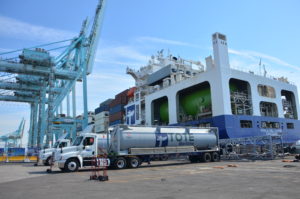 Two JAXPORT tenants, TOTE Maritime Puerto Rico and Crowley Maritime Corp., are leaders in the emergence of liquified natural gas (LNG) as a preferred, environmentally-friendly fuel source for the maritime industry. The benefits of LNG over traditional fuel include a significant reduction in carbon dioxide and other greenhouse gas emissions. JAXPORT is the only East Coast port to serve vessels powered by LNG with on-dock and near-dock fueling capabilities. Additionally, four Jacksonville LNG facilities currently under construction: a liquefaction plant in West Jacksonville, able to produce 200,000 gallons a day, a production and storage facility near the Blount Island Terminal, a holding facility at Talleyrand Marine Terminal, and a liquefaction and storage facility at Dames Points with the capacity to produce in excess of 120,000 gallons of LNG per day.
Two JAXPORT tenants, TOTE Maritime Puerto Rico and Crowley Maritime Corp., are leaders in the emergence of liquified natural gas (LNG) as a preferred, environmentally-friendly fuel source for the maritime industry. The benefits of LNG over traditional fuel include a significant reduction in carbon dioxide and other greenhouse gas emissions. JAXPORT is the only East Coast port to serve vessels powered by LNG with on-dock and near-dock fueling capabilities. Additionally, four Jacksonville LNG facilities currently under construction: a liquefaction plant in West Jacksonville, able to produce 200,000 gallons a day, a production and storage facility near the Blount Island Terminal, a holding facility at Talleyrand Marine Terminal, and a liquefaction and storage facility at Dames Points with the capacity to produce in excess of 120,000 gallons of LNG per day.
Port Everglades
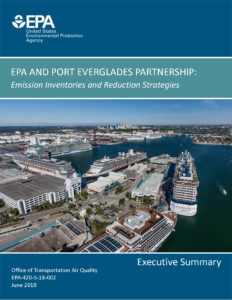 In 2016, EPA’s Office of Transportation and Air Quality and Broward County’s Port Everglades announced a voluntary partnership (PDF) to study mobile source emissions. Through this partnership that has now concluded, EPA and PEV agreed to work together to develop baseline and future year emission inventories and to evaluate various effective technology and operational strategy scenarios for seaports. Port Everglades is the first port to partner with EPA in this way.
In 2016, EPA’s Office of Transportation and Air Quality and Broward County’s Port Everglades announced a voluntary partnership (PDF) to study mobile source emissions. Through this partnership that has now concluded, EPA and PEV agreed to work together to develop baseline and future year emission inventories and to evaluate various effective technology and operational strategy scenarios for seaports. Port Everglades is the first port to partner with EPA in this way.
The EPA and Port Everglades partnership led to the development of the Port Everglades 2015 Baseline Air Emissions Inventory, as well as documentation of methods, lessons learned, and practical examples that can inform other ports, related agencies, and stakeholders.
Port Everglades
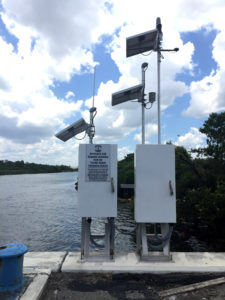
Valuable data for storm and climate change preparedness is now being collected at Port Everglades by the Physical Oceanographic Real-Time System (PORTS®), a device recently developed and installed by the National Oceanic and Atmospheric Administration (NOAA). The installation includes a Micro-Wave water level sensor (MWWL) that is a non-contact highly accurate sensor used to measure distance and can be used to monitor long-term sea level changes. The back-up water level sensor is a pressure-based sensor that measures water-level. The meteorological station has been located on the roof of the Port’s Harbormaster Tower and is outfitted with primary back-up wind sensors that provide wind speed and direction. Broward County’s Environmental Planning & Community Resilience Division co-sponsored the PORTS device.
In addition to storm and climate change preparedness data and sea level changes, the device also records real-time tides, currents, and other meteorological information. Access to the data is available on the Port’s website at porteverglades.net (top of the homepage under “Tides & Currents”) or via phone at 866-213-5269. Read full story.
Port Everglades
 Broward County has transferred ownership of approximately 60 acres of wetlands habitat at Port Everglades, including a successful 16.5-acre Wetland Enhancement project, to the State of Florida for its permanent protection as a conservation area. In addition, the State is developing a memorandum of understanding with the South Florida Audubon Society to manage the conservation area. The land transfer completes a critical component of the Port Everglades Southport Turning Notch Extension project that will increase berth space for cargo ships at the berth-constrained seaport.
Broward County has transferred ownership of approximately 60 acres of wetlands habitat at Port Everglades, including a successful 16.5-acre Wetland Enhancement project, to the State of Florida for its permanent protection as a conservation area. In addition, the State is developing a memorandum of understanding with the South Florida Audubon Society to manage the conservation area. The land transfer completes a critical component of the Port Everglades Southport Turning Notch Extension project that will increase berth space for cargo ships at the berth-constrained seaport.
Port of Pensacola

The Port of Pensacola Warehouse #1 continues to be recognized as a Bird-Friendly Rooftop by Audubon Florida, in partnership with the National Fish and Wildlife Foundation and the Florida Fish and Wildlife Conservation Commission. Now, more than 70 active Least Tern nests are documented on Port of Pensacola’s Warehouse #1 roof during a recent site visit by Audubon of Florida’s Rooftop Nesting Bird Program. A team of wildlife observers visited the Port of Pensacola and inspected the rooftop for evidence of bird nests, eggs and hatchlings. Warehouse #1’s gravel overlay provides an artificial nesting habitat that is similar to the natural sand beach nesting habitat preferred by Least Terns and Black Skimmers. The warehouse rooftop was first officially recognized in 2015.
Port Canaveral
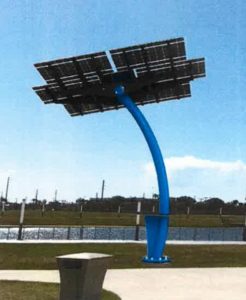
As part of Florida Power & Light’s (FPL) SolarNow community program, five Solar Trees will soon be constructed at the Port’s Exploration Tower and Jetty Park playground. The electricity-generating “trees” are the newest additions to a lineup of solar energy projects FPL is installing and operating in public areas such as parks, zoos, hospitals, airports and museums around the state. Funding comes from voluntary monthly contributions by FPL customers to the SolarNow solar partnership pilot program, and the clean renewable energy produced is fed to the grid to benefit the entire community. In addition to generating clean electricity, the trees — especially the two large ones adjacent to the playground at Jetty Park — will provide shade. Each of the three trees along the sidewalk at the Exploration Tower will also offer a small covered table and mobile-device charging stations for the use of visitors.
Port Tampa Bay
Port Tampa Bay recently announced the close of another successful nesting season for the nesting migratory birds that makes the port’s two dredge material management areas their summer home in Hillsborough Bay under the oversight of the Migratory Bird Protection Implementation Committee. It is a cooperative effort between the port authority, Audubon Florida, the U.S. Army Corps of Engineers, the Florida Fish and Wildlife Conservation Commission, and other local, state, and federal agencies to protect the nesting birds.
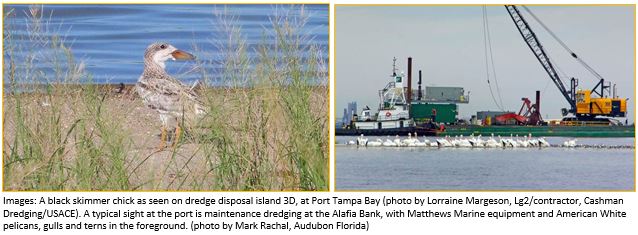
JAXPORT
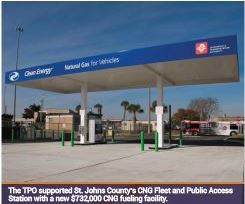
Initiatives to reduce the amount of petroleum used in Northeast Florida transportation and at JAXPORT have culminated in two important outcomes: federal recognition for a clean fuel effort and a clean truck program helping small and independent truck owners upgrade to cleaner equipment. The port’s new Clean Truck Program aims to help small, independent truck owner/operators upgrade their trucks to cleaner energy fuels. More than 150 local trucking companies have been contacted through the initiative.
A multi-faceted rehabilitation project of Berth 35 at JAXPORT’s Blount Island Marine Terminal is nearing completion with the installation of a high-voltage electrical system in anticipation of the arrival of three new 100-gauge electric container cranes this month. The berth’s improvements increase energy efficiencies, reduce emissions from diesel-powered cranes and enhance night-time operations through new high-powered LED lighting. Berth 35’s new electrical system includes an on-site transformer substation and $1 million switchgear building to feed each crane’s power needs. The 100-gauge cranes will work on regenerative power, consuming power during the lifting of containers and creating energy as they lower.
PortMiami
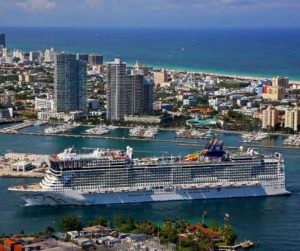 Waste Management worked with Norwegian Cruise Line to launch the “Live Load” service model to meet the waste and recycling needs of all the company’s ships in the Port of Miami including its newest ship, the 4,500-passenger, Norwegian Epic. The Norwegian Epic is twice as large, with twice the waste volume of any ship Waste Management was currently servicing. Instead of using multiple roll-off containers and multiple pick-ups, a more efficient semi-trailer with a side curtain is used to haul the residual materials. This new model captures numerous commodities with a single transport vehicle as well as provides a platform to further divert other commodity categories. On board, waste materials are separated including glass, cardboard, paper, plastic, aluminum, steel, e-waste and dry waste. The materials are then sorted, processed, baled and placed on pallets which are loaded by forklift directly into the curtain side trailer which arrives dockside featuring “just in time service” on the same day and time every week.
Waste Management worked with Norwegian Cruise Line to launch the “Live Load” service model to meet the waste and recycling needs of all the company’s ships in the Port of Miami including its newest ship, the 4,500-passenger, Norwegian Epic. The Norwegian Epic is twice as large, with twice the waste volume of any ship Waste Management was currently servicing. Instead of using multiple roll-off containers and multiple pick-ups, a more efficient semi-trailer with a side curtain is used to haul the residual materials. This new model captures numerous commodities with a single transport vehicle as well as provides a platform to further divert other commodity categories. On board, waste materials are separated including glass, cardboard, paper, plastic, aluminum, steel, e-waste and dry waste. The materials are then sorted, processed, baled and placed on pallets which are loaded by forklift directly into the curtain side trailer which arrives dockside featuring “just in time service” on the same day and time every week.
The materials are delivered to Waste Management’s Reuter Recycling Center in Pembroke Pines, the largest single-stream recycling facility in the Southeastern United States. The recyclables are consolidated onto outbound trucks ready for market. The dry waste is sent to the firm’s nearby Wheelabrator waste-to-energy plant. This process, which has never been done before in the cruise line industry, also benefits port operations by removing the waste immediately from the site, and offers better security from a border patrol standpoint.
Port Everglades
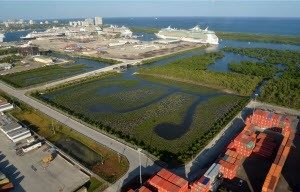 Port Everglades Wetland Enhancement Project recently received a “Notification of Trending Towards Success” from the Florida Department of Environmental Protection for successfully cultivating 16.5 acres of nursery-grown mangrove and native plants on property that was originally dry land intended for other uses. The notification is a critical component to the Port’s Southport Turning Notch Extension Project because it releases 8.7 acres of an existing mangrove conservation easement adjacent to Berth 30. The Wetlands project also won IHS Maritime and Trade Magazine’s Dredging and Port Construction Innovation Award in the “Working/Engineering/Building with Nature Award” category.
Port Everglades Wetland Enhancement Project recently received a “Notification of Trending Towards Success” from the Florida Department of Environmental Protection for successfully cultivating 16.5 acres of nursery-grown mangrove and native plants on property that was originally dry land intended for other uses. The notification is a critical component to the Port’s Southport Turning Notch Extension Project because it releases 8.7 acres of an existing mangrove conservation easement adjacent to Berth 30. The Wetlands project also won IHS Maritime and Trade Magazine’s Dredging and Port Construction Innovation Award in the “Working/Engineering/Building with Nature Award” category.
Broward County’s Port Everglades has hired local environmental science and planning veteran Erik Neugaard as its new Environmental Program Manager within the Seaport Engineering and Construction Division to oversee all environmental functions and procedures associated with operations and development at the South Florida cruise, cargo and petroleum port. Neugaard has 24 years of experience as an environmental scientist and planner with the Miami-Dade County Department of Environmental Resources Management, Florida Department of Transportation, and as a consultant.
Port Canaveral
 Concerned about idle trucks and vans in the port, Fleet Manager Brian Carroll looked up idle times and posted them on a shop bulletin to show drivers. In March 95.5 hours were spent idling, but by informing drivers about the idle times that number lowered to 24.9 hours in June, a 74 percent drop in just four months. It was highlighted as a “13 Bright Ideas for Fleet Improvement” in Government Fleet magazine.
Concerned about idle trucks and vans in the port, Fleet Manager Brian Carroll looked up idle times and posted them on a shop bulletin to show drivers. In March 95.5 hours were spent idling, but by informing drivers about the idle times that number lowered to 24.9 hours in June, a 74 percent drop in just four months. It was highlighted as a “13 Bright Ideas for Fleet Improvement” in Government Fleet magazine.
The Port Environmental Department teamed up with more than 150 volunteers from Carnival Cruise Line, SeaWorld and regional coordinator Keep Brevard Beautiful (KBB) to join in the International Coastal Cleanup on September 17. The cleanup focused on the shoreline areas of the public boat ramp complex, park and beach. Volunteers collected more than 100 bags of trash and 25 bags of recyclables.
Port Tampa Bay
Port Tampa Bay and the Southwest Florida Water Management District’s SWIM (Surface Water Improvement and Management) Program partnered on two major environmental enhancements that won a national award from the American Association of Port Authorities in 2014. A 19-acre estuarine wetlands system was created on low-lying port property as mitigation for the port’s newest berth. The project connects freshwater marshes with mangroves and oyster reefs through a series of tidal channels. Birds flocked to the new site even before the bulldozers had left. Read full article from Bay Soundings.
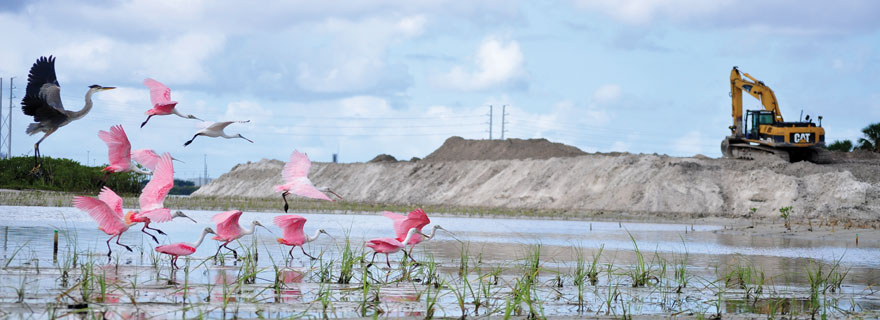
Port Tampa Bay
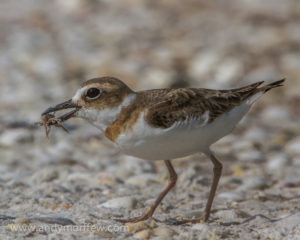 Florida Shorebird Alliance works with Port Tampa Bay to protect birds on Spoil Island. Spoil Island 3D,a man-made island created with bottom material dumped after nearby channel dredging, serves as important habitat for myriad bird species. Some of those species are deemed “imperiled” by Florida Fish and Wildlife, but find refuge on the island’s quiet shores. As regular dredging efforts continue in order to keep the nearby shipping channel clear, material is added to the island to create additional bird habitat. Florida Shore Bird Alliance works with Port Tampa Bay to protect birds on Spoil Island. Watch video here.
Florida Shorebird Alliance works with Port Tampa Bay to protect birds on Spoil Island. Spoil Island 3D,a man-made island created with bottom material dumped after nearby channel dredging, serves as important habitat for myriad bird species. Some of those species are deemed “imperiled” by Florida Fish and Wildlife, but find refuge on the island’s quiet shores. As regular dredging efforts continue in order to keep the nearby shipping channel clear, material is added to the island to create additional bird habitat. Florida Shore Bird Alliance works with Port Tampa Bay to protect birds on Spoil Island. Watch video here.
Port Panama City
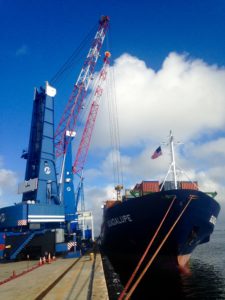 Port Panama City purchased a 100-ton Gottwald all-electric mobile harbor crane in 2014. The port recently converted a second mobile harbor crane from diesel generated electric power to electric power supplied directly from the grid. In doing this, the port will reduce fuel consumption by 15,000 gallons per year and reduce carbon emissions from these cranes by 90 percent.
Port Panama City purchased a 100-ton Gottwald all-electric mobile harbor crane in 2014. The port recently converted a second mobile harbor crane from diesel generated electric power to electric power supplied directly from the grid. In doing this, the port will reduce fuel consumption by 15,000 gallons per year and reduce carbon emissions from these cranes by 90 percent.
Port of Palm Beach

The Port of Palm Beach’s ‘green’ efforts include coral moving and manatee protection. More than 600 corals have been harvested in the waters off the port and moved to Palm Beach’s offshore coral nursery. Other projects have included installing 137 manatee fenders to keep the animals from being squeezed between a ship and a seawall. Learn more in this Palm Beach Post article.
Directors of Environmental Affairs
Many Florida seaports have directors of environmental affairs to ensure the ports continue to sustain and find new ways to protect Florida’s natural resources. These directors keep track of seagrass and coral health, water quality improvement projects, recycling initiatives, habitat restoration projects, environmentally friendly ships, and community partnerships.

